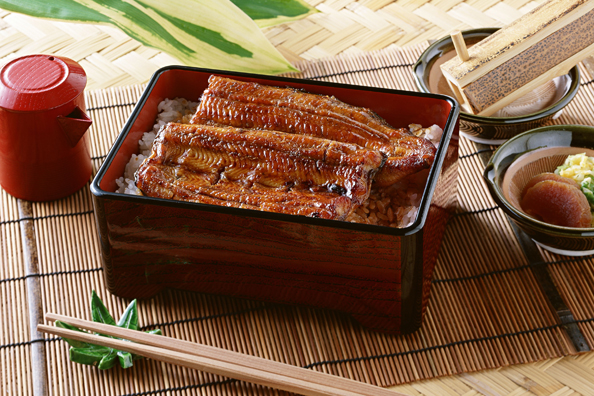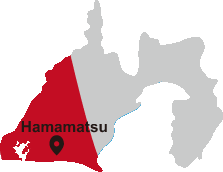Hamamatsu is famous for freshwater Unagi (eel)!
Eat your fill of delicious eel in Hamamatsu!
Lake Hamana, a lake located in western Hamamatsu, Japan is a prosperous location for raising eel, oyster, nori, and soft-shelled turtles. It is especially famous throughout Japan for its production of eel. For more than 100 years the lake has been the number 1 producer of eel in Japan. Its central position as an area of eel production has fostered a booming commercial trade and Hamamatsu still does the most commercial selling of eels within Japan today. Hamamatsu is home to the highest class of restaurants specializing in eel dishes, which has established it as the place to eat eel. If you hear Hamamatsu, you think of eel.

Kanto style and Kansai style eel
There are two different styles of preparing eel dishes: Kanto (Tokyo area) style and Kansai (Kyoto and Osaka area) style. Geographically Hamamatsu is located in between these two regions and both styles can be enjoyed here. Because the method of filleting and cooking the eel varies between the two styles, the texture and flavors are also different. Test your taste buds with both styles to both to compare before choosing your favorite.
Kanto Style
Kanto style eel is filleted by slicing open the eel's back. Next it is lightly grilled then steamed in a basket. Then it is drizzled with tare sauce and grilled again. Kanto style eel is known for being moist and tender.
Kansai Style
Kansai style eel is prepared by slicing the eel's belly. The whole fillets are then skewered on metal skewers, seasoned with tare sauce and grilled over an open flame. Kansai style eel is not steamed and is known for being flavorful and slightly crispy.
NOTE
One explanation for the different methods of filleting the fish by slicing the belly or the back lies in Japanese history. Historically, Edo (Tokyo, in Kanto), was the seat of samurai power. Creating an eel fillet by slicing open the belly reminded samurai of seppuku--ritual suicide by slicing open one's own belly--so they preferred splitting the eel at the back. Kyoto and Osaka (in the Kansai region) were commercial districts and the people there were known to "talk with their bellies split open," a phrase in Japanese meaning they speak frankly with each other. This saying is attributed as one reason why the Kansai region prepares eel by opening the belly.
Doyo no Ushi no Hi
(Midsummer Day of the Ox)
(Midsummer Day of the Ox)
In Japan, one of the features of summer is known as the Midsummer Day of the Ox.
The four seasons are distinct in Japan, but the 20-day period between two seasons is known as doyo. The day of the ox (ushi no hi) refers to the ox in the Japanese zodiac. There are twelve animals in the zodiac so the day of the ox comes once every 12 days. So, in fact, the day of the ox does not only occur in the 20 days between summer and autumn, but for some reason the phrase doyo no ushi no hi has come to represent only the Midsummer Day of the Ox. This is probably because people eat foods like eel that increase energy levels during the height of the overwhelming heat of the Japanese summer that leaves them feeling lethargic.
The four seasons are distinct in Japan, but the 20-day period between two seasons is known as doyo. The day of the ox (ushi no hi) refers to the ox in the Japanese zodiac. There are twelve animals in the zodiac so the day of the ox comes once every 12 days. So, in fact, the day of the ox does not only occur in the 20 days between summer and autumn, but for some reason the phrase doyo no ushi no hi has come to represent only the Midsummer Day of the Ox. This is probably because people eat foods like eel that increase energy levels during the height of the overwhelming heat of the Japanese summer that leaves them feeling lethargic.
2015.5.20 update
Content may be subject to change after publication. Please also note that we are not accountable for loses and damages that may occur as a result of said changes.
Content may be subject to change after publication. Please also note that we are not accountable for loses and damages that may occur as a result of said changes.





